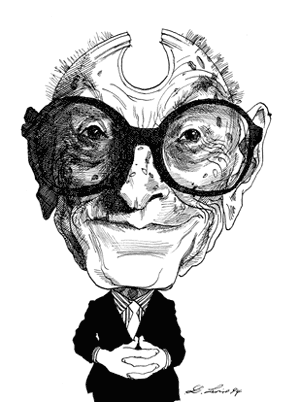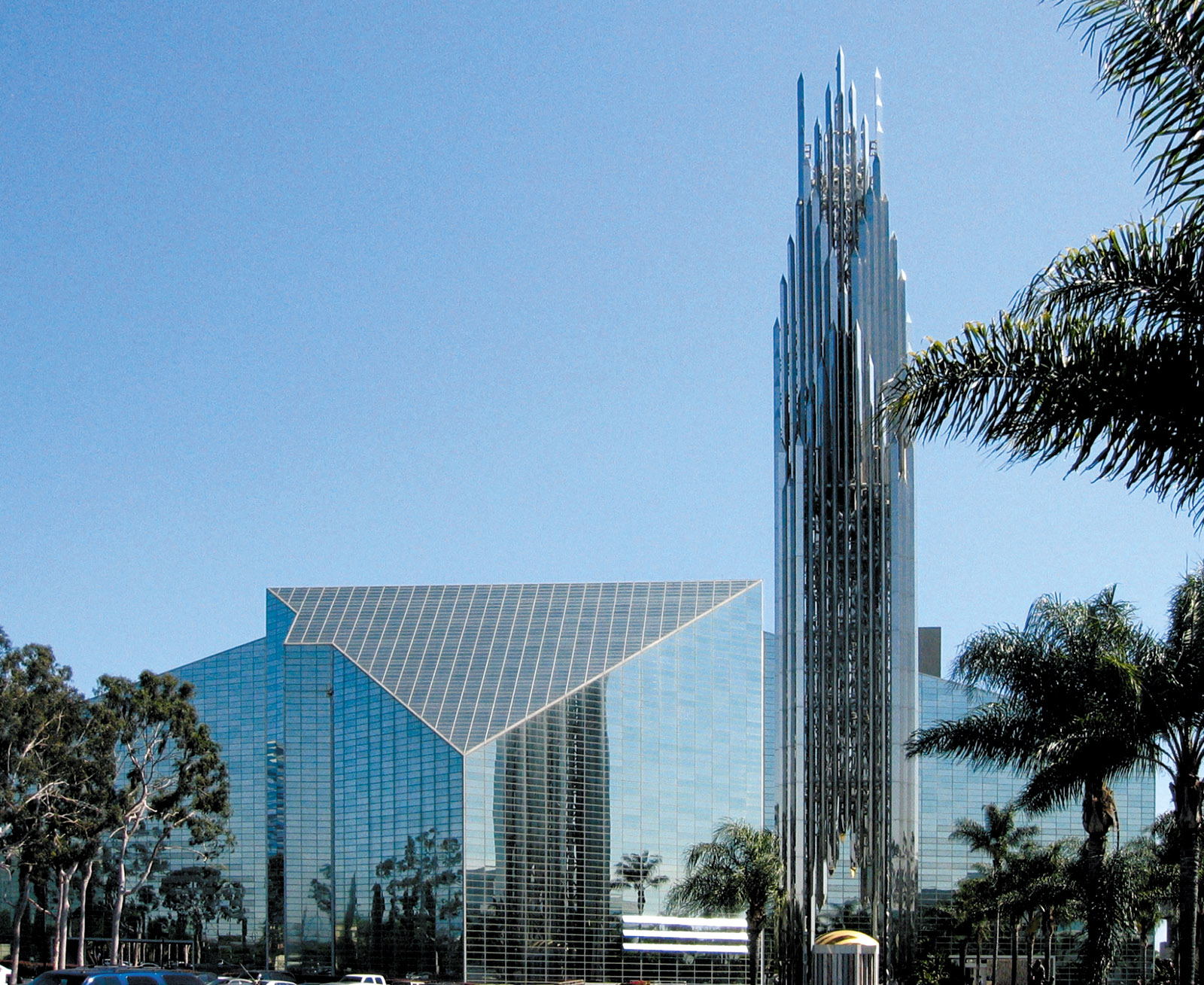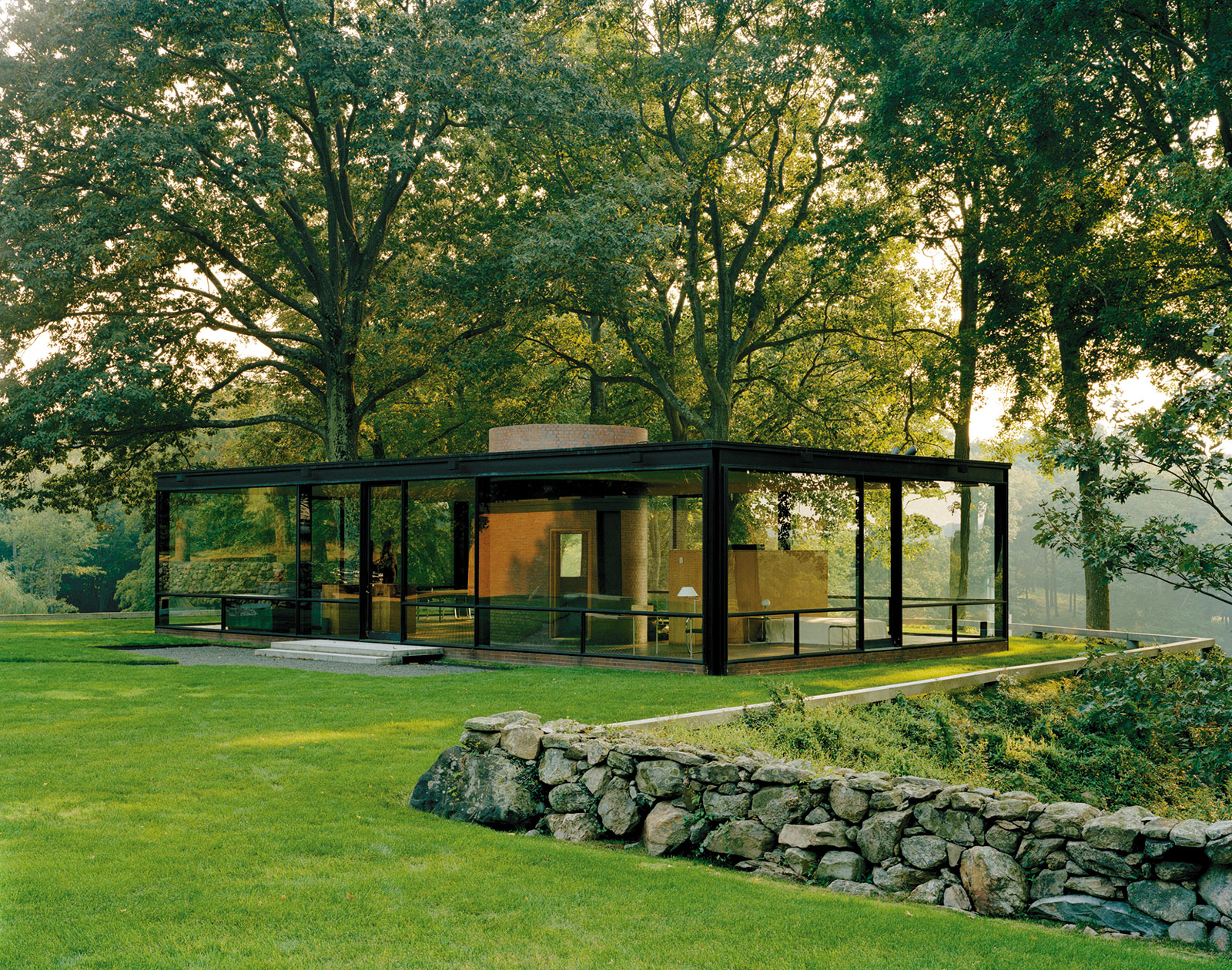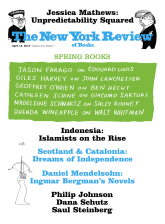1.
As a young architecture writer I resolved to steer clear of all enterprises that involved Philip Johnson, convinced that this charming cultural corrupter, as I saw him, was the very antithesis of my socially conscious role model, the architecture critic Lewis Mumford. Avoidance of Johnson, however, was easier imagined than accomplished, since the first decades of my career—the 1970s and 1980s—coincided with the professional apogee of the man then reflexively called “the dean of American architects” or, less reverently, “the Godfather of American architecture” because of the powerful but largely hidden influence he wielded, not unlike that of a mafia don. He decided who got reputation-making exhibitions, conferred architectural commissions awarded through the many juries he served on, and distributed lesser jobs he himself was offered but uninterested in to grateful younger practitioners.
Nothing says more about Johnson’s high status at that time than his being named the first recipient of the Pritzker Prize for Architecture in 1979, because, as its benefactors made known, he alone among all living master builders possessed the gravitas needed to establish the award’s international prestige. Yet also alive at the time were such greatly superior architects as Luis Barragán, who went on to win the Pritzker, and Marcel Breuer and Josep Lluís Sert, who did not.
Try as I might, I couldn’t wholly avoid this maestro of manipulation, who insinuated himself into seemingly every aspect of the New York art and architecture scene, particularly at the influential Institute for Architecture and Urban Studies (the avant-garde think tank he helped fund) and the Museum of Modern Art, whose department of architecture and design he had founded in 1932; its chief curator customarily served at his pleasure, and Johnson remained a MoMA trustee throughout the last five decades of his life. But as Mark Lamster notes in his searing yet judicious new biography, The Man in the Glass House, Johnson excelled at disarming his detractors through self-deprecating responses to even their harshest criticism.
I experienced this phenomenon in 1981 when my unflattering profile “Philip Johnson at 75: The Power and the Paradox” was published.1 Right after it appeared I got a call from Johnson, who said how clever I was and claimed to agree with what I wrote. Perhaps he had this passage in mind:
Johnson has produced enough good architecture in his lifetime—the Glass House, the Museum of Modern Art extensions and garden, the Four Seasons, the IDS Center, and Pennzoil Place, to name some of his most successful works—to offset the much larger volume of questionable or downright bad design he has done. His contradictory nature and inconsistent output will keep critics guessing long after Philip Johnson has departed from the scene. And that’s just the way he would like it.
Nothing he did in the twenty-four years that remained to him ever made me want to revise a word of that, least of all concerning his delight in throwing people off his trail.
I soon realized that even if I had written something negative about his latest building, I could always contact him for a pithy quote on some current topic. He also agreed to be the through-line commentator in Beyond Utopia: Changing Attitudes in American Architecture, a 1983 documentary directed by Michael Blackwood, for which my wife, Rosemarie Haag Bletter, and I conducted the interviews and wrote the script. The film focused on five rising stars whose work Johnson championed (and appropriated ideas from): Peter Eisenman, Michael Graves, Frank Gehry, Denise Scott Brown, and Robert Venturi. He turned in a sparkling performance, but although he insisted that there is no such thing as bad publicity, he was annoyed when we gave him the last word with a clip in which he mused:
We think we’re creating architectural history—I guess all architects do, whether they’re good or not—but are we? Or are we doing what a lot of critics would accuse us of doing, and that is kitsch?
2.
Johnson’s fame skyrocketed during the prosperous 1980s, thanks mainly to his being taken up by the Houston-based developer Gerald Hines, who hired him to design a series of office skyscrapers across the country that dramatically redirected his practice, which until then had been based on private houses and buildings for the arts and education. Hines realized that if he exercised strict control over budgets—always a problem with artistically ambitious architects—he could exploit a celebrity designer’s cachet as a marketing device, a strategy that other developers soon copied.
Johnson became more than famous: he became the best-known architect among the general public since Frank Lloyd Wright, who likewise had been an instinctive self-promoter. His office overflowed with commissions from AT&T, IBM, PPG, and other corporate giants for whom he created eye-catching if aesthetically dubious Postmodern towers. Johnson’s principal partner from 1967 to 1991 was the pragmatic-minded John Burgee, and their work during this period was formally credited to Johnson/Burgee Architects. The collaboration ended when Burgee ousted the octogenarian Johnson from the firm, a foolhardy move that bankrupted Burgee and ended his career, while Johnson formed a new partnership with Alan Ritchie that continued until his death.
Advertisement
As his burgeoning public profile prompted growing demand for a full-scale biography, he chose the architectural historian Franz Schulze of Lake Forest College to write Philip Johnson: Life and Work, which appeared in 1994.2 Schulze’s acclaimed 1985 biography of Ludwig Mies van der Rohe made Johnson think he had found his perfect chronicler. According to Lamster, Johnson considered Schulze’s hardly uncritical Mies study to be “hagiography”—a desirable attribute for him—but this was a mismatch of author and subject from the outset. The credulous, earnest, and forthright Schulze was ill-equipped to deal with Johnson, who was wily as a fox and slippery as an eel, a veritable one-man Aesop’s fable. He could also be as mean as a snake, evident when he called Gerald Hines—who made him independently rich (after Johnson depleted his inherited wealth through decades of cultural philanthropy and high living)—“the world’s dullest man.” Hines, perhaps worried about losing his golden goose, blandly claimed that “I let it slide off my back…. That was part of his personality.”
Johnson, like many gay men of his generation in the arts, neither concealed nor broadcast his sexuality, though with Schulze he openly discussed his private relationships, including his nearly half-century domestic partnership with the contemporary art curator and installation expert David Whitney, who was thirty-two years his junior. Schulze’s biography provided a seemingly complete roster of Johnson’s romantic involvements, though Lamster comes up with yet another major affair previously unrecorded, as well as other less-enduring liaisons. But of far more interest and importance than the architect’s love life is the previously unrevealed extent of his involvement with Nazi Germany.
That Johnson had been an ardent fascist starting in his twenties was common knowledge ever since he quit his post as MoMA’s first curator of architecture and design in 1934 to organize an American nationalist counterpart to the Nazi Party. Johnson’s buffoonish experiment in grassroots politics may now seem like the satirical plot of a movie by Preston Sturges, but he was deadly serious in his intent if not adept in his methodology. Years later he tried to ascribe his enthusiasm for Hitler to the homoerotic appeal of Aryan stormtroopers in hypermasculine military uniforms. But this was no mere sexual fetish, as shown by his extensive writing for Social Justice, the white supremacist, anti-Semitic paper published by the hate-mongering Catholic radio evangelist Father Charles Coughlin. Among Johnson’s contributions were his eyewitness accounts as a reporter for Social Justice before and during the German invasion of Poland in 1939. In a dispatch written just before the war broke out and subtitled “Jews Dominate Polish Scene,” he described the contrast between Nazi Germany and Poland in its last days of freedom:
Once on the Polish side I thought at first that I must be in the region of some awful plague. The fields were nothing but stone, there were no trees, mere paths instead of roads. In the towns there were no shops, no automobiles, no pavements and again no trees. There were not even any Poles to be seen in the streets, only Jews!
Jews, Lamster writes, “he considered a stateless caste,” and he saw the Poles as a “subhuman Slavic racial type” and their subjugation by the Nazis as “legitimate.”
Lamster goes further than any previous writer in asserting that Johnson was infinitely worse than a misguided, impressionable youth who fell for Hitlerian theatrics: he was in effect an unpaid spy for the Nazi regime. There seems to be no reason to doubt this accusation after evaluating his thoroughly documented and convincingly laid out case. He works carefully through the network of political relationships that led Johnson from his futile attempts to replicate a native fascist movement in New York and the American Midwest (presumably because he grew up in Ohio and also knew well-connected people there) to direct collaboration with the Hitler regime, and rightly sees Lawrence Dennis—an older fellow Harvard graduate of mixed black and white heritage (a fact Dennis concealed) who wrote books in support of the Nazi agenda—as the most important figure in Johnson’s direct dealings with secret agents of America’s incipient enemy.
Dennis introduced him to, among other Nazi contacts, Ulrich von Gienanth, the propaganda attaché at the German embassy in Washington in the late 1930s who simultaneously served as an intelligence officer for the SS. Schulze makes one brief mention of Gienanth, but Lamster identifies him as a crucial conduit in Johnson’s freelance espionage. Unmentioned by Schulze but highlighted by Lamster is Hans-Heinrich Dieckhoff, the German ambassador to the US from 1937 to 1938, who first met Johnson in Berlin and whose friendship with him continued even after the diplomat was recalled to Germany following Kristallnacht.
Advertisement
But what was the exact nature of Johnson’s covert activity during this period? If Lamster discovers no smoking gun, he nonetheless finds an awful lot of smoke:
According to records captured after the war, the Nazi diplomats were specifically interested in obtaining mailing lists and names of individuals who might be sympathetic to their cause. Johnson…was in a position to deliver precisely that type of material.
This, as Lamster elaborates with excerpts from a letter he found in Johnson’s FBI file, was
a subject he raised specifically in April of 1939 with Viola Heise Bodenschatz, the author of a series of self-published pro-German pamphlets [and the sister-in-law of General Karl-Heinrich Bodenschatz, Hermann Göring’s chief of staff and liaison officer to Hitler]. “What interests me especially is, how do you get distribution?” he wrote to her. “That seems to me the key question of those of us who would like to get some daylight into the ever darkening atmosphere of contemporary America.”
But as Lamster is careful to point out:
There is no evidence, however, that he violated American law. There was nothing illegal about Johnson speaking privately with Nazi officials in 1939. Those conversations would have become unlawful only had Johnson accepted financial remuneration from the German government—an act that would have made him an unregistered agent of a foreign power…. But for Johnson money was never an issue: he was insulated by his own wealth. Indeed, he was the ideal vehicle for the Nazis, a man willing and able to finance their interests out of his own pocket.
All this suggests that Johnson was eerily like sinister characters in two 1946 films, Alfred Hitchcock’s Notorious and Orson Welles’s The Stranger, which portrayed wealthy fifth columnists who surreptitiously worked in the upper echelons of society to advance the Nazi cause in this hemisphere. More astounding than Johnson’s treachery remains how he evaded any long-term consequences for it, which had less to do with his inveterate shape-shifting than an inexplicable lack of curiosity among the plutocratic clients who later hired him. This was particularly true of the many Jewish benefactors of the same cultural institutions he supported, none more so than MoMA, to say nothing of the many journalists who established his high critical reputation.
3.
Another theme in The Man in the Glass House concerns the steady support Johnson received from America’s most influential newspaper, The New York Times, thanks to its apostolic succession of architecture critics during his heyday, all of whom Lamster—now the architecture critic of the Dallas Morning News—believes Johnson had won over. The paper’s prevailingly positive treatment of Johnson began with Ada Louise Huxtable (the first regular Times architecture critic, a position created in 1963) and continued with her immediate successors, Paul Goldberger and Herbert Muschamp.
Such favoritism may seem surprising of Huxtable, who enjoyed a long-standing reputation for disinterested probity that precluded the overt power schmoozing pursued by subsequent occupants of her position. But from 1946 to 1950 the young Huxtable worked under Johnson as a curatorial assistant in MoMA’s architecture and design department, and a more binding debt of gratitude was yet to come. The architect, in what Lamster describes as “one of his more cynical coups,” commissioned her and her husband, the industrial designer L. Garth Huxtable, to create the tableware for the Four Seasons Restaurant in his and Mies van der Rohe’s Seagram Building of 1954–1958 in New York.
By then Huxtable had begun writing for the Times, and as Johnson eventually admitted, he gave the job to the couple “for obvious reasons. To get good notices in the Times.” The Four Seasons was a masterful synthesis of late International Style design that evoked the majestic proportions of interwar luxury liners and employed the Miesian formula of rich materials handled with utter simplicity. Although it ranks among the genuine triumphs of Johnson’s oeuvre, this consummate strategist was not about to take any chances with its critical reception.
Thereafter, and until his indefensible AT&T corporate headquarters of 1979–1984 in New York—with its campy Chippendale split-pediment roof, which she deplored in a break with her mentor—Johnson, Lamster writes, “could still count on his old protégé, Ada Louise Huxtable, for a full-throated, well-argued defense.” Take, for example, her baffling praise for his Brutalist addition of 1967–1972 to McKim, Mead & White’s Boston Public Library, a Beaux-Arts landmark. Although I find that the graceless three-level Johnson design resembles a public parking garage, she wrote, “It poses, and solves, a number of functional, structural, environmental and esthetic problems with mastery, and represents…what the best architecture has always been about.”
Huxtable was equally off base in lauding Johnson’s dreadful unexecuted 1966 plan for Ellis Island, which would have replaced its historic structures with a ten-story circular Brutalist ziggurat—imagine an inverted, externalized version of Frank Lloyd Wright’s Guggenheim Museum—inscribed with the names of the millions of immigrants who passed through America’s most renowned port of entry. Doubtless in response to public outrage, the Times took the extraordinary step of countering her review with a scathing editorial that characterized Johnson’s design as “a rheostat cast in concrete.”
He found a no-less-reliable advocate in Paul Goldberger, the Times’s chief architecture critic for ten years after Huxtable’s departure in 1982. In one of the many backbends that marked his tenure, Goldberger wrote of Johnson/Burgee’s glitzy, glass-walled Crystal Cathedral of 1977–1980 in Garden Grove, California (built for the televangelist Robert Schuller’s Hour of Power broadcasts), “If this is not the deepest or the most profound religious building of our time, it is at least among the most entertaining.” And he deemed one of Johnson’s tawdriest designs—the Crescent of 1982–1985 in Dallas, a thudding 1.25-million-square-foot mixed-use commercial complex tarted up with mansard roofs and lacy metalwork balconies à la New Orleans’s French Quarter—a “marvelous confection.”
Goldberger’s fulsome 2005 Times obituary of Johnson tiptoed so lightly around the architect’s Nazi connections that the paper felt compelled to run a counter-obit by the art critic Mark Stevens on its Op-Ed page four days later. Titled “Form Follows Fascism,” this corrective called for historical accountability and amounted to the Times’s mea culpa for its fawning treatment of him. In it, Stevens quoted from a 1973 interview in which the architect, who’d supposedly renounced Nazism long before, let slip, “About Hitler—if he’d only been a good architect!”
4.
Goldberger’s successor, Herbert Muschamp, whom Lamster calls “one of Johnson’s staunchest guardians,” maintained that his architecture held “the irresistible allure of the fantastic, an apparition, a dream…. Slight though much of his work may be, it nonetheless challenges us to rethink the prospects for architecture as a social art.” This is nonsense, for the one thing Johnson most conspicuously lacked was an interest in architecture’s social responsibility, a question that on several occasions he said bored him.
Such a lack of interest was evident in his strongest claim to historical fame, as cocurator with Henry-Russell Hitchcock of MoMA’s epochal 1932 “Modern Architecture: International Exhibition,” which gave currency to the label “International Style” as a synonym for modern architecture. Yet Hitchcock and Johnson’s pioneering effort was undermined by being narrowly selective, highly aestheticized, and deeply misleading. Their severely edited approach to innovative building design in the first third of the twentieth century oversimplified a complex development that had many unruly subplots inimical to the curators’ desire for a neatly streamlined narrative.
They erred most egregiously in ignoring the deep political and social motivations of the Modern Movement in architecture, which was rooted in the comprehensive reform initiatives that accompanied the rise and spread of social democracy after World War I in the Western European countries where the International Style took hold most vigorously. To address the central subject of social housing for workers, arguably the foremost initiative of the Modern Movement between the world wars, they engaged Lewis Mumford to contribute to the exhibition and its publication, but they marginalized his efforts in both instances.
A virtual aesthetic vampire, Johnson habitually drained meaning from architecture by reducing it to a consumable style. He repeated this tendency in his and Mark Wigley’s strenuously hyped 1988 MoMA exhibition “Deconstructivist Architecture,” with which he hoped to recapture the glory of his early curatorial days at the museum as his working relationship with Burgee soured. The organizers highlighted the work of an emergent avant-garde generation—including Rem Koolhaas, Zaha Hadid, and Daniel Libeskind, among others—who shared a common aesthetic of angular lines, fragmented forms, and shattered surfaces, with a superficial resemblance to Russian Constructivist architecture from the years just before and after the November Revolution. The title of the show also alluded to Deconstruction, an approach to literary criticism that had become increasingly fashionable in academic circles during the preceding decade. But neither of those two reference points was explored adequately in the show or its slender catalog, and Johnson’s bid for renewed clout as a curatorial impresario fizzled.
Despite his stupendous conventional success, a nagging sense of insecurity never left him. His unfailing ability to gauge the artistic quality of others became his own curse of Cassandra, in that he could foresee what many did not perceive about him: that his was a bubble reputation, which expanded and shone during his lifetime but would inevitably burst after his death, when the sheer force of his personality could no longer keep the myth of Philip Johnson afloat.
To counter the possibility of posthumous oblivion, he decided to bequeath his forty-seven-acre New Canaan, Connecticut, estate to the National Trust for Historic Preservation, and thereby made his canniest bid for architectural immortality. The Glass House and the thirteen ancillary structures he added around it over five decades provide a concise survey of the architect’s successive stylistic vagaries—1950s Miesian, 1960s “Ballet School” Neoclassical (a pejorative coined by the British critic Reyner Banham), 1970s Brutalist, 1980s Postmodernist, and 1990s Deconstructivist—and chart the course of his career much more winningly than his large-scale work. When Johnson learned that the National Trust required a considerable endowment to pay for a property’s ongoing upkeep as a precondition for such a gift, he and Whitney agreed that the proceeds from their extensive art collection should go toward this most personal memorial. It was the smartest money they ever spent.
5.
Although the subtitle of Lamster’s insightful investigation might at first seem like marketing overreach, there is little question that Johnson, if scarcely his celebrity-worshiping epoch’s finest architect, was perhaps its most representative one. He repackaged the Modern Movement from a high-minded agent for social change into the International Style, and then embraced Postmodernism as a parade of marketable modes for corporate interests. If this self-confessed nihilist embodied one principle—though he reminded a conference of fellow architects in 1982, “I do not believe in principles, in case you haven’t noticed”—it was his contempt for the Modern Movement’s utopian promise. He rejected this perhaps unattainable goal not because he thought it was beyond the power of his profession to save the world all by itself but because he cared not a whit about improving the lot of those he saw as his inferiors.
In this regard he was no different from the current president of the United States, and the business connections between the two have given Lamster a final chapter more grotesque than even his darkly cynical subject could have predicted. Marshaling details that few are likely to remember, he revisits his subject’s history with Donald Trump, who in 1983 hired Johnson to design Trump Castle, a $200 million condominium tower at Madison Avenue and 60th Street that would have featured a moat, drawbridge, crenellations, and pinnacles coated in gold leaf. “Very Trumpish,” a deadpan Johnson commented to the Times.
Fortunately that project fell through, though Trump returned again and again to Johnson, who in 1995–1997 refashioned the exterior of Thomas E. Stanley’s Gulf and Western Building of 1968–1970 in New York, now the Trump International Hotel and Tower, with gold-tinted glass as stipulated by his patron. Although in private the architect was withering about his crassest client, he intuited the importance of flattering him profusely, and proclaimed on The Charlie Rose Show, “I never worked with anyone as bright and quick and decisive as Donald Trump.”
The bankruptcy-prone developer also tried, unsuccessfully, to engage Johnson in a partial remake of his foundering Taj Mahal Hotel and Casino in Atlantic City. Their day trip to inspect the gaudy property produced an exchange that encapsulates both Trump’s phallic strutting and Johnson’s shrewdness. As Lamster writes, the host offered his guest his own philosophy of women:
Trump: You have to treat ’em like shit.
Johnson: You’d make a good mafioso.
Trump: One of the greatest.
It took an experienced Godfather to recognize a wannabe mobster.
In the early weeks of 2005 Johnson died, at the age of ninety-eight, in the most elegant sickroom imaginable, the Glass House, the open-plan interior of which had been outfitted with a hospital bed that, along with around-the-clock nursing care, made it possible for its architect to spend his final days overlooking the site of some of his happiest moments as a cultural power broker. His rigorous aestheticism persisted to the very end. Lamster poetically reconstructs his exit scene:
A gentle snow began to fall through the New Canaan woods. Johnson had always thought the Glass House was most magical that way; the falling snow created the illusion that you were rising on what he called a “celestial elevator.”
Whitney died five months afterward, aged sixty-six. Their ashes were scattered on the grounds of the Glass House compound, which has become a lively arts center of just the sort they imagined. This oasis of refined pleasure seems as remote as possible from the grim realities of daily life for much of humanity—a disparity that the most principled of his fellow modern architects sought to redress, and that Philip Johnson tried so hard to ignore.
This Issue
April 18, 2019
‘I Have Let Whitman Alone’
Ingmar Bergman, Novelist
-
1
Architecture Minnesota, June/July 1981. ↩
-
2
See my review in these pages, December 22, 1994. ↩






